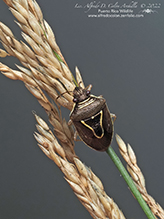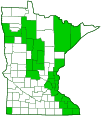Stink bug
(Mormidea lugens)
Conservation • Description • Habitat • Ecology • Distribution • Taxonomy
Conservation Status |
|||
| IUCN Red List | not listed |
||
| NatureServe | NNR - Unranked |
||
| Minnesota | not listed |
||
Description |
Mormidea lugens is a common, easily recognized, relatively small stink bug. It occurs in the United States and southern Canada east of the Great Plains. Adults are active from May through August. They are found in grasslands and agricultural fields. They feed on grasses, sedges, a variety of herbaceous plants, and a few deciduous trees. Adults are 3⁄16″ to ¼″ (5.0 to 7.2 mm) in length. The body is shield shaped. The upper side is brown. The head is small and narrow, much narrower than the thorax. It is tucked into a concave groove in the margin of the pronotum. There is no visible “neck” when viewed from above. There are two large, bulging, compound eyes and two small simple eyes (ocelli). The mouth parts are optimized for piercing and sucking, and take the form of a thick, curved, 3-segmented beak (rostrum). The rostrum is longer than the head and fits into a groove on the underside (sternum) when not in use. The antennae are exposed, conspicuous, slender, and long, much longer than the head but not as long as the body. The exoskeletal plate covering the thorax (pronotum) is wide, giving the body a broad-shouldered appearance. The angles in the shoulder (humeral) area on each side are rounded and have no projecting tooth. On the front half of the pronotum there are two transverse, ivory-colored lines. The lateral and rear margins have a thin ivory-colored border. There are two pairs of wings, and they are held flat over the body when at rest. Between and at the wing bases there is a triangular plate (scutellum). The forewings (hemelytra) on the mature adult are as long as the abdomen but do not completely cover the sides of the abdomen. The hemelytra have a thickened section at the base and a thin membranous section at the tip with a clear dividing line between the two. The thickened basal part is comprised of a narrow area (clavus) behind the scutellum when the wings are closed, and the remaining broad marginal area (corium). The scutellum is triangular and large, covering about half of the abdomen, but it is not longer than the corium, and it does not reach the tip of the abdomen. It is narrowed on the rear third then tapered to the tip. The lateral margins have an ivory-colored border. The hindwings are thin, membranous, and concealed under the hemelytra. The legs are pale. On the hind legs, the fourth segment (tibia) has an indistinct and incomplete groove above. The last part of the leg (tarsus), corresponding to the foot, has 3 segments. |
Size |
Total length: 3⁄16″ to ¼″ (5.0 to 7.2 mm) |
Similar Species |
Habitat |
Grasslands and agricultural fields |
Ecology |
Season |
May through August |
Behavior |
|
Life Cycle |
|
Food |
Grasses, sedges, herbaceous plants, and deciduous trees |
Distribution |
||
|
Sources Biodiversity occurrence data published by: Minnesota Biodiversity Atlas (accessed through the Minnesota Biodiversity Atlas Portal, bellatlas.umn.edu, 8/25/2025). The Heteroptera (Hemiptera) of North Dakota I: Pentatomomorpha: Pentatomoidea Rider D.A. 2012. Great Lakes Entomol. 45: 312‒380. |
|
| 8/25/2025 | ||
Occurrence |
||
Common |
||
Taxonomy |
|
Order |
Hemiptera (True bugs, Hoppers, Aphids, and Allies) |
Suborder |
Heteroptera (True Bugs) |
Infraorder |
Pentatomomorpha |
Superfamily |
Pentatomoidea (stink bugs, shield bugs, and allies) |
Family |
|
Subfamily |
Pentatominae |
Tribe |
Carpocorini |
Genus |
Mormidea |
Subordinate Taxa |
|
|
|
Synonyms |
|
|
|
Common Names |
|
This species has no common name. The common name of the family Pentatomidae is stink bugs, and it is applied here for convenience. |
|
Glossary
Corium
The thickened basal portion of the front wing that lies between the clavus and the membrane of insects in the family Hemiptera. Plural: coria.
Hemelytron
The forewing of true bugs (Order Hemiptera), thickened at the base and membranous at the tip. Plural: hemelytra.
Ocellus
Simple eye; an eye with a single lens. Plural: ocelli.
Pronotum
The exoskeletal plate on the upper side of the first segment of the thorax of an insect.
Rostrum
The stiff, beak-like projection of the carapace or prolongation of the head of an insect, crustacean, or cetacean.
Scutellum
The exoskeletal plate covering the rearward (posterior) part of the middle segment of the thorax in some insects. In Coleoptera, Hemiptera, and Homoptera, the dorsal, often triangular plate behind the pronotum and between the bases of the front wings. In Diptera, the exoskeletal plate between the abdomen and the thorax.
Tarsus
On insects, the last two to five subdivisions of the leg, attached to the tibia; the foot. On spiders, the last segment of the leg. Plural: tarsi.
Tibia
The fourth segment of an insect leg, after the femur and before the tarsus (foot). The fifth segment of a spider leg or palp. Plural: tibiae.
Visitor Photos |
Share your photo of this insect. |
||
This button not working for you? |
||
Alfredo Colon |
 |
MinnesotaSeasons.com Photos |
|

Slideshows |
|

Visitor Videos |
Share your video of this insect. |
||
This button not working for you? |
||
|
Other Videos |
Male stink bugs fight for the right to mate | Mormidea lugens |
About
Feb 15, 2022 Male stink bugs fight for the right to mate | Mormidea lugens |
Stink Bug (Mormidea lugens) |
About
Jul 7, 2018 |

|
Created: Last Updated: © MinnesotaSeasons.com. All rights reserved. |


